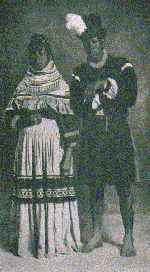
Black Seminole: Did you know that the Seminole never signed a Treaty with the United States
Ernest Rauthschild
You mentioned earlier the tribe called Washitaw Moor. Was this a Native American tribe and where are they now?



 The Washitaw was originally from lower Mississippi, Louisiana, and Alabama (named after Nubian-Sudanese Ali Baba). The tribe was officially named "Wichita" by the U.S. Government in the Camp Holmes Treaty of 1835. This tribe were unmistakably a Negroid tribe! The Wichita were also known as "Paniwassaha" or by the French "Panioussa" which means "Black Pawnee." French traders from Illinois called them "Pani Pique" which means "Tattooed Pawnee."
The Washitaw was originally from lower Mississippi, Louisiana, and Alabama (named after Nubian-Sudanese Ali Baba). The tribe was officially named "Wichita" by the U.S. Government in the Camp Holmes Treaty of 1835. This tribe were unmistakably a Negroid tribe! The Wichita were also known as "Paniwassaha" or by the French "Panioussa" which means "Black Pawnee." French traders from Illinois called them "Pani Pique" which means "Tattooed Pawnee."
The Washitaw or "Racoon People" were called Racoons because of their black faces. When describing the Washitaw, the French describes the blacks who lived in large grass houses. The Washitaw called themselves "Kitikitish" which is an interpretation of "Raccoon Eyed." The term was later shortened to "Coon" which became a term used in reference to blacks in America. The Washitaw were an offshoot of the Pawnee Confederation. When the Moors came to America, they mixed in with the Washitaw Native Americans and became known as "Washo."
So the Washitaw Moors are the so-called "Lost" tribe of Indians that are spoken of in the history books? Yes! They are the hidden tribe that were the descendants of the Olmecs and Toltecs of Mexico. The Washitaw tribe are also the ancestors to such tribes as Pawnee, Osage, Creek, Seminole, Cherokee, Catawba, Comanche, Nez Perce, Tuscarora, Gingaskin, Mattaponi, Powhatten, Micmac, Lumbi, Mandan, Blackfoot, Natchez, Chickasaw, and many more tribes.
Were the Black Indians ever sold into slavery?
The misconception is that Black Indians were never taken into slavery. This is not the case. Black Indians were also captured and sold into slavery along with their African cousins. The land of the Black Indians were taken. Louisiana, Georgia, Alabama, Texas, Oklahoma, Mississippi, Illinois, Florida, Delaware, Tennessee, Kansas, Iowa, Indiana all belonged to the Washitaw Moors. The land was invaded by the French and British. The women were sold as sex slaves and the men were sold into slavery as "Negros." The U.S. Government even persuaded the red Indian tribes to own slaves. The Cherokee, Choctaw, Creek, and Chickasaw tribes all agreed to slave holding of black Indians and Africans. The only tribe to resist the idea of slavery was the Seminole tribe. The Seminoles rejected the idea because they were the descendants of African explorers who settled in Florida and mixed with Muskogee refugees who had mixed in with the Spanish. They called themselves "Runaways." These black Seminoles who settled in the swampy terrain of Florida established cultivation methods that were identical to that of the methods of Sierre Leone in Africa. Georgia slave holders were soon invading Florida looking for runaway slaves and were soon met with opposition with Seminoles.
The Seminoles tried to live a peaceful life in their own territory but Georgia militias were preparing to raid Florida looking for African slaves (many whom had already sought refuge with the Seminoles and blended in perfectly since both Africans and Seminoles were black.) The Seminoles, African runaways, and the Spanish all aligned with each other to fight off the slave holders. In 1739 slave fugitives in St. Augustine built a fort to protect themselves and the British. Black Seminoles led the coalition against slavery in the North. Black Seminoles even planted "spies" posing as African slaves being sold by Creeks to the British just to gather information. Eventually the red Seminoles began to join the resistance. This is when the U.S. Government became worried. The government never anticipated the well working relationship between the reds and blacks. Georgia slave holders soon realized that the Seminole Nation could put an end to slavery. This caused the first Seminole War. Seminoles struck U.S. slave plantations. When the St. Augustine blacks joined in the Seminole raids were destructive and the Seminoles could not be stopped. General Andrew Jackson of the U.S. Military vowed to wipe out the Seminoles. The Seminoles took control of a British fortress and re-named it "Fort Negro" which was manned by black Seminole officers. The Seminole army consisted of 300 Seminole men in which only 34 were red Indians.
African slaves began to join the army the Seminoles seemed indestructible. With General Andrew Jackson's rank on the line, he gathered U.S. troops, Marines and sought the assistance of 500 Creek Indians. Jackson's orders were to kill the Seminoles, blow up the fort and restore the Africans to their rightful owners. A war erupted after the Seminoles refused surrender and a cannon ball was fired into the Fort Negro's ammunition barracks which blew up the fort. In the ruins, 270 Seminoles were dead, 64 were fatally wounded and the leader of the Seminole resistance, Garcia was captured alive and then executed. General Jackson kept this incident a secret from the public for 20 years because Jackson never had an official declaration of war signed, therefore it was considered murder, not war. However, this massacre was only the beginning of the Seminole resistance and was only the first of three Seminole wars that would carry on for years. The remaining black Seminoles relocated to the Tampa Bay area where they nursed their wounds and prepared for the next battle. The Seminoles this time joined forced with Chief Billy Bowlegs. Without the U.S. Congress knowledge, Andrew Jackson went on a rampage throughout Florida burning black Seminole villages of Fowltown. When James Monroe took the U.S. Presidency in 1817, Jackson proposed a secret plan to take Florida from the Seminoles who at the time owned certain territories of Florida.
 Jackson soon captured Pensacola and without a declaration of war, Florida passed into U.S. hands! Another state owned by blacks that the U.S. captured. Since Florida was officially Spanish territory, the U.S. paid Spain $5 million for Florida, making Jackson's illegal seizure appear as a real estate purchase. The U.S. then tried to separate the black and red Seminoles by trying to convince the Seminole leader King Hatchy to turn over anyone who had black skin. King Hatchy replied that he would use force if any government tried to pass through the Seminole territory and he would not hand over any black Seminoles. To disrupt racial alliance between blacks and reds, the U.S. promoted slavery among the Seminoles and tried to convince them that the other "Indian" nations were also interested in slavery. The Seminoles rejected. The U.S. then sent in wealthy Creek Indians who owned slaves to persuade their tribal cousin the red Seminoles to become slave holders. Whites and Creek Indians were encouraged to raid black Seminole villages for slaves. Free Seminole men, women, and children were carried off and sold in southern slave markets as "Negros." Many black Seminoles relocated further into the swamps and became known as "Maroon." Other black Seminoles agreed to be taken into slavery as long as they were able to own their own cattle, horses, hogs, and were treated like family rather than like their African cousins.
Jackson soon captured Pensacola and without a declaration of war, Florida passed into U.S. hands! Another state owned by blacks that the U.S. captured. Since Florida was officially Spanish territory, the U.S. paid Spain $5 million for Florida, making Jackson's illegal seizure appear as a real estate purchase. The U.S. then tried to separate the black and red Seminoles by trying to convince the Seminole leader King Hatchy to turn over anyone who had black skin. King Hatchy replied that he would use force if any government tried to pass through the Seminole territory and he would not hand over any black Seminoles. To disrupt racial alliance between blacks and reds, the U.S. promoted slavery among the Seminoles and tried to convince them that the other "Indian" nations were also interested in slavery. The Seminoles rejected. The U.S. then sent in wealthy Creek Indians who owned slaves to persuade their tribal cousin the red Seminoles to become slave holders. Whites and Creek Indians were encouraged to raid black Seminole villages for slaves. Free Seminole men, women, and children were carried off and sold in southern slave markets as "Negros." Many black Seminoles relocated further into the swamps and became known as "Maroon." Other black Seminoles agreed to be taken into slavery as long as they were able to own their own cattle, horses, hogs, and were treated like family rather than like their African cousins.
These black Seminoles had equal liberty with whites. These Seminoles were not considered slaves but they were considered Seminoles who maintained their African names, dressed in fine Seminole clothing, and turbans. The remaining Seminoles migrated to Mexico for 20 years and others migrated to Texas and mixed in with the black tribes of the Washitaw.
